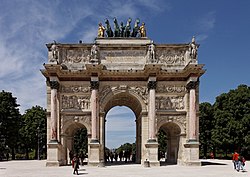Our website is made possible by displaying online advertisements to our visitors.
Please consider supporting us by disabling your ad blocker.
Neoclassical architecture
Top: The Petit Trianon (Versailles, France), 1764, by Ange-Jacques Gabriel; Centre: The Brandenburg Gate (Berlin, Germany), 1791, by Carl Gotthard Langhans; Bottom: Arc de Triomphe du Carrousel (Paris), 1806–1808, by Pierre-François-Léonard Fontaine | |
| Years active | 18th century–mid-20th century |
|---|---|
Neoclassical architecture, sometimes referred to as Classical Revival architecture, is an architectural style produced by the Neoclassical movement that began in the mid-18th century in Italy, France and Germany.[1] It became one of the most prominent architectural styles in the Western world.[2] The prevailing styles of architecture in most of Europe for the previous two centuries, Renaissance architecture and Baroque architecture, already represented partial revivals of the Classical architecture of ancient Rome and ancient Greek architecture, but the Neoclassical movement aimed to strip away the excesses of Late Baroque and return to a purer, more complete, and more authentic classical style, adapted to modern purposes.
The development of archaeology and published accurate records of surviving classical buildings was crucial in the emergence of Neoclassical architecture. In many countries, there was an initial wave essentially drawing on Roman architecture, followed, from about the start of the 19th century, by a second wave of Greek Revival architecture. This followed increased understanding of Greek survivals. As the 19th century continued, the style tended to lose its original rather austere purity in variants like the French Empire style. The term "neoclassical" is often used very loosely for any building using some of the classical architectural vocabulary.
In form, Neoclassical architecture emphasizes the wall rather than chiaroscuro and maintains separate identities to each of its parts. The style is manifested both in its details as a reaction against the Rococo style of naturalistic ornament, and in its architectural formulae as an outgrowth of some classicizing features of the Late Baroque architectural tradition. Therefore, the style is defined by symmetry, simple geometry, and social demands instead of ornament.[3] In the 21st century, a version of the style continues, sometimes called New Classical architecture or New Classicism.
- ^ "Western architecture - German Gothic, Baroque, Renaissance | Britannica".
- ^ "Neoclassical architecture". Encyclopædia Britannica. Retrieved 7 July 2017.
- ^ Middleton, Robin. (1993). Neoclassical and 19th century architecture. Electa. ISBN 0-8478-0850-5. OCLC 444534819.
Previous Page Next Page
عمارة كلاسيكية جديدة Arabic Arquiteutura neoclásica AST Neoklassik memarlığı AZ Класіцызм (архітэктура) BE Неокласическа архитектура Bulgarian নব্য-ধ্রুপদীয় স্থাপত্য Bengali/Bangla Neoklasicistička arhitektura BS Arquitectura neoclàssica Catalan Klasicistní architektura Czech Νεοκλασική αρχιτεκτονική Greek





